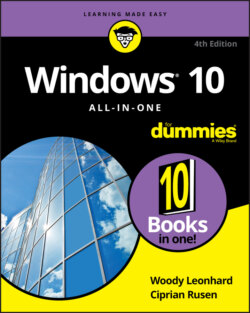Читать книгу Windows 10 All-in-One For Dummies - Ciprian Adrian Rusen, Woody Leonhard - Страница 88
Keying Keyboard Shortcuts
ОглавлениеWindows 10 has about a hundred zillion — no, a googolplex — of keyboard shortcuts.
I don’t use very many of them. They make my brain hurt.
Here are the keyboard shortcuts that everyone should know. They’ve been around for a long, long time:
Ctrl+C copies whatever you’ve selected and puts it on the Clipboard. On a touchscreen, you can do the same thing in most applications by tapping and holding down, and then choosing Copy.
Ctrl+X does the same thing but removes the selected items — a cut. Again, you can tap and hold down, and Cut should appear in the menu.
Ctrl+V pastes whatever is in the Clipboard to the current cursor location. Tap and hold down usually works.
Ctrl+A selects everything, although sometimes it’s hard to tell what “everything” means — different applications handle Ctrl+A differently. Tap and hold down usually works here, too.
Ctrl+Z usually undoes whatever you just did. Few touch-enabled apps have a tap-and-hold-down alternative; you usually have to find Undo on a ribbon or menu.
When you’re typing, Ctrl+B, Ctrl+I, and Ctrl+U usually flip your text over to Bold, Italic, or Underline, respectively. Hit the same key combination again, and you flip back to normal.
In addition to all the key combinations you may have encountered in Windows versions since the dawn of 19th-century dentistry, there’s a healthy crop of new combinations. These are the important ones:
The Windows key brings up the Start menu.
Alt+Tab cycles through all running Windows programs, one by one — and each running Legacy desktop app is treated as a running program. (Windows key+Tab treats the entire desktop as one app.) See Figure 1-11.FIGURE 1-11: Alt+Tab cycles through all running apps.
Ctrl+Alt+Del — the old Vulcan three-finger salute — brings up a screen that lets you choose to lock your PC (flip to Book 2, Chapter 2), switch the user (see Book 2, Chapter 4), sign out, or run the new and much improved Task Manager (see Book 8, Chapter 4).
You can also right-click the Start icon or press Windows key+X to bring up the Power User menu shown in Figure 1-12.
FIGURE 1-12: The Win-X, or Power User, menu can get you into the innards of Windows 10.
And finally, the trick I know you’ll use over and over. Starting with Windows 10 Fall Creators update, version 1709, there’s a new built-in emoji keyboard. Simply click wherever you want to type an emoji, hold down the Windows key, and press the period. See Figure 1-13.
Who says Windows 10 isn’t as cool as your smartphone? Only took Microsoft a decade or so.
FIGURE 1-13: Emojis are — finally! — just a keyboard command away.
